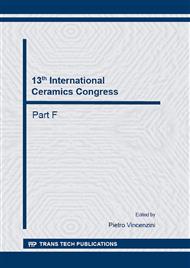[1]
R. McCaffrey, Climate Change and the Cement Industry, Global Cement and Lime Magazine (Environmental Special Issue), (2002), 15-19.
Google Scholar
[2]
J. Davidovits, High-Alkali Cements for 21st Century Concretes. in Concrete Technology, Past, Present and Future, Proceedings of V. Mohan Malhotra Symposium, Editor: P. Kumar Metha, ACI SP- 144, (1994), 383-397.
DOI: 10.14359/4523
Google Scholar
[3]
P. Duxson, Provis J L, Lukey G C and J. S. J. van Deventer, The Role of Inorganic Polymer Technology in the Development of Green Concrete, Cement and Concrete Research, 37(12), (2007), 1590-1597.
DOI: 10.1016/j.cemconres.2007.08.018
Google Scholar
[4]
E. Gartner, Industrially Interesting Approaches to 'Low-CO2' Cements, Cement and Concrete Research, 34(9), (2004), 1489-1498.
DOI: 10.1016/j.cemconres.2004.01.021
Google Scholar
[5]
J. Davidovits, Soft Mineralogy and Geopolymers, Proceedings of the of Geopolymer 88 International Conference, the Université de Technologie, Compiègne, France, (1988).
Google Scholar
[6]
J. van Jaarsveld, G. S., J. S. J. van Deventer, L. Lorenzen, The Potential Use of Geopolymeric Materials to Immobilise Toxic Metals, Part I. Theory and Applications, Minerals Engineering 10(7), (1997), 659-669.
DOI: 10.1016/s0892-6875(97)00046-0
Google Scholar
[7]
H. Rahier, Van Mele B, Biesemans M, Wastiels J, Wu X, Low temperature synthesized aluminosilicate glasses, Part I, lowtemperature reaction stoichiometry and structure of a model compound, J Mater Sci., 31, (1996), 71–79.
DOI: 10.1007/bf00355128
Google Scholar
[8]
F. Barbosa Valeria, J.D. Mackenzie Kenneth., Thermal behavior of inorganic geopolymes and composites derived from sodium polysialate, Mater Res Bull, 2143, (2002), 1–13.
Google Scholar
[9]
F. Barbosa Valeria , J.D. Mackenzie Kenneth, Synthesis and thermal behavior of potassium sialate geopolymers. Mater Lett., 2002, 4012.
Google Scholar
[10]
E. Lyon Richard, Fire resistant aluminosilicate composites. Fire Mater, 21, (1997), 67–73.
Google Scholar
[11]
M. Palomo A, Blanco-Varela T, Granizo ML, Putertas F, Vazquez T, MW. Grutzeck Chemical stability of cementitious materials based on metakaolinite. Cement Concrete Res, 29, (1999), 997– 1004.
DOI: 10.1016/s0008-8846(99)00074-5
Google Scholar
[12]
D. C. Comrie, Geopolymer technology and its application to waste remediation. Report, Krystal Bond Inc., Ottawa, (2000).
Google Scholar
[13]
T. Tho-in, Sata V, Chindaprasirt P, C. Jaturapitakkul, Previous high-calcium fly ash geopolymer concrete, Constr. Build Mater., 30, (2012), 366–371.
DOI: 10.1016/j.conbuildmat.2011.12.028
Google Scholar
[14]
S. Bachvarov , Technology of ceramics products, Technics, Sofia, (2003).
Google Scholar
[15]
Bhavneet Singh, Bleeding in Concrete, Int. Journal of Civil Engineering and Technology (IJCIET), Volume 4, Issue 2, March - April (2013), 247-249.
Google Scholar
[16]
B. Joseph, G. Mathew, Influence of aggregate content on the behavior of fly ash based geopolymer concrete. Scien Iranica; 19, (2012), 1188–1194.
DOI: 10.1016/j.scient.2012.07.006
Google Scholar


